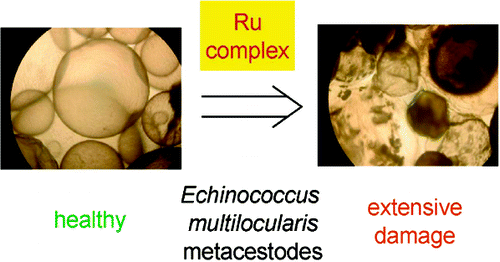Potential new drugs for fox tapeworm infection in humans

Scientists are reporting development and testing of a new series of drugs that could finally stop the fox tapeworm — which causes a rare but life-threatening disease in humans — dead in its tracks. The report, which appears in ACS' Journal of Medicinal Chemistry, shows that specific organometallic substances that help combat cancer are also the surprising best new hope for a treatment against tapeworm infection.
Carsten Vock, Andrew Hemphill and colleagues explain that alveolar echinococcosis (AE) is a parasitic disease caused by the fox tapeworm Echinococcus multilocularis. Although rare, AE disease results in the death of about 94 percent of patients worldwide within 10-20 years of diagnosis if not treated appropriately. Most infections occur in the Northern hemisphere, in places like central Asia, northwestern China, and parts of Japan and Europe. People become infected from eating food contaminated with the parasite's eggs, which are found in the feces of infected foxes, cats or dogs. Surgery is the best option for AE patients, but it does not always remove all of the parasites. Current AE drugs do not cure the disease, but simply keep the parasites at bay. These medicines must be taken life-long. In AE patients, the tapeworms cause tumor-like growths, which can metastasize or spread to different parts of the body. This reminded the researchers of cancer, so they looked at whether ruthenium complexes, promising anti-cancer agents, could also treat tapeworm.
The group prepared and evaluated several ruthenium complexes as potential drugs against the fox tapeworm. Some were effective in killing the tapeworms and also were less toxic on normal cells in laboratory dish tests, making them prime candidates for further development as treatments for AE.
More information: A New Promising Application for Highly Cytotoxic Metal Compounds: η6-Areneruthenium(II) Phosphite Complexes for the Treatment of Alveolar Echinococcosis, J. Med. Chem., 2012, 55 (9), pp 4178–4188. DOI: 10.1021/jm300291a
Abstract
Two series of η6-areneruthenium(II) phosphite complexes were prepared, characterized, and evaluated in vitro for their toxic potential against Echinococcus multilocularis metacestodes. Neutral complexes of general formula [(η6-p-cymene)RuCl2{P(OR)3}] (R = Et, iPr, Ph) with two easily exchangable chloride ligands showed only minor toxicity, whereas the substitution of these moieties against a β-diketonate (2,2,6,6-tetramethylheptanedionate) ligand led to hydrolytically stable complex salts of type [(η6-p-cymene)Ru(β-diketonate){P(OR)3}][BF4] (R = Et, iPr, Ph) with comparable in vitro toxicity (50% PGI release at c = 1.4 – 4.7 μM) to the reference drug nitazoxanide (50% PGI release at c = 1.2 μM). In addition, the latter complexes were highly toxic against rat hepatoma cells (IC50 = 0.40–2.0 μM) and less toxic against human foreskin fibroblasts (IC50 = 1.1–2.9 μM) and Vero cells (IC50 = 1.2–8.9 μM). The measured cytotoxicities against mammalian cells are, to the best of our knowledge, among the highest ever observed for ruthenium-based complexes. In conclusion, complex salts of type [(η6-p-cymene)Ru(β-diketonate){P(OR)3}][BF4] might be interesting candidates for further development toward anthelmintic drugs and/or highly cytotoxic metal compounds.
Journal information: Journal of Medicinal Chemistry
Provided by American Chemical Society















